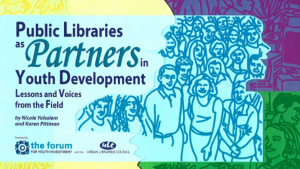 Effectiveness. Scale. Sustainability.
Effectiveness. Scale. Sustainability.
Most nonprofits struggle to achieve these three goals. Few struggle more than youth service providers.
They struggle to demonstrate effectiveness because it’s difficult to measure the problems they prevent, and almost as hard to measure a youth’s development. They struggle to go to scale because doing so forces them to replicate or expand services to attract new funding for growth, when they need more money just to meet current demands. They struggle to sustain their work because public funding streams are fragmented and shrinking, private funders cycle through programs and issues in ways that often don’t square with reality, and many of the families that providers serve can’t pay enough to support the programs.
I, too, struggle to reach these goals as co-founder and CEO of the Forum for Youth Investment, a national nonprofit that’s been around since 1998. We work with local leadership groups and networks of providers to improve youth services and supports – and that experience tells me that keeping a local direct service agency afloat is even more difficult. So I offer the following advice with grains of salt.
Think partnerships.
Forming effective partnerships can help nonprofits achieve all three of these crucial goals. We’ve used partnerships to help our organization get better and stronger, and to increase our reach.
I realize that partnering well is tricky. During the past few months, I’ve had several opportunities to facilitate conversations with management staff from local youth-serving organizations who are being encouraged to “partner together for collective impact.” I’ve learned that the response of nonprofit leaders to this urging depends a lot on their sense of security: Do they see their organizations as the beneficiaries or casualties of this shared commitment to align resources?
The best way to stay afloat on the collective impact wave is to remember that partnerships come in lots of shapes and sizes. Youth-serving organizations need to enter into the right arrangements with the right partners for the right reasons. For example:
One-on-one partnering agreements can increase organizational efficiency and effectiveness. Partners create formal or informal agreements to routinize the use of complementary resources (e.g., space or buses) or referrals for complementary services (e.g., health screenings or specialized sports). Community-based organizations (CBOs) sometimes develop a formal memorandum of understanding to offer new blended services (e.g., jointly staffed after-school programs). Organizations like Communities in Schools act as designated hubs to coordinate access to the services of multiple CBOs.
Partner network or system agreements can increase efficiency, effectiveness and sustainability. Networks or systems of providers allow their members to define and implement common standards, assessments, measures and service agreements. These can help CBOs improve and streamline their work, often through peer-to-peer supports from other organizations. These partnerships also improve the ability of their members to be informed about and represented in discussions about broader policies, programs and practices that can increase the sustainable flow of resources to the field, especially if participating organizations agree to be held accountable for shared outcomes.
Collective impact agreements can increase effectiveness, sustainability and scale. High-level commitments to improve outcomes for all youth in a given region typically require increased commitments to scale up critical services and opportunities. Those service commitments, in turn, carry requirements for accountability, effectiveness and efficiency that make it difficult for individual organizations (especially small nonprofits) to meet the new demands on their own. That’s why it’s important for direct-service organizations to participate in strong provider networks and systems.
Remember, however, that provider networks and collective impact partnerships operate with different denominators. Provider networks work to demonstrate improved results among youth served by their member programs. Collective impact partnerships work to demonstrate improved results among all youth in a defined area. The latter can’t be achieved without the former. The former can’t be achieved without better collaboration and coordination among service providers. Sustainable scaling-up of services and supports requires both approaches.
So, as you look to make your nonprofit more effective, to expand it and to make it last, look carefully at your partnerships. Figure out how to invest your time in those that are most critical to your organization’s success. Figure out how you can ensure the success of your network or system. Treat partnering not just as a nice way of doing business; treat it as a strategy for your business to thrive.
Karen Pittman is co-founder and CEO of the Forum for Youth Investment, a nonprofit that helps communities make sure all young people are “ready by 21 for college, work and life.”



No comment yet, add your voice below!